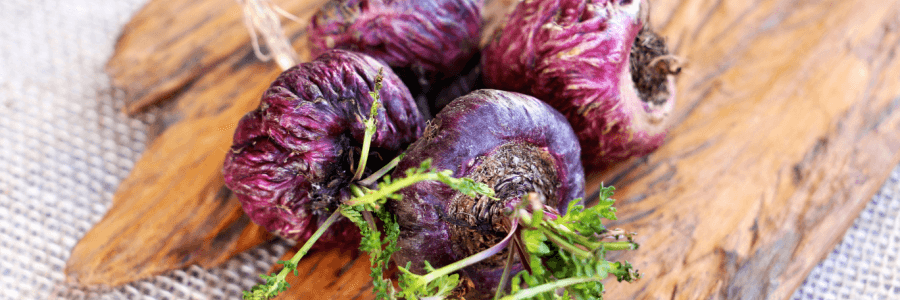Red Maca Root: History, Potential Benefits & Nutrition Guide
|



Red Maca, a root vegetable scientifically known as Lepidium meyenii, is a Peruvian plant that has been cultivated and used as a food supplement for more than 2,000 years. It is also heavily used for its medicinal properties that have been traditionally described and passed down from generation to generation. This rare vegetable is rich in vitamins, minerals, antioxidants, and nutrients that can support overall health and wellness.
The goal of this article is to provide basic foundational information about Red Maca and how you might be able to benefits from its consumption.
- Red Maca: An Overview
- A Short History
- Where Is Maca Found?
- Why Are People Eating Roots?
- Main Highlights & Potential Benefits
- Red Maca Powder Nutritional Profile
- Conclusion
Red Maca: An Overview
Scientific Name: Lepidium meyenii.
Other Names: Ginseng Andin, Peruvian Ginseng, Lepidium meyenii, Lepidium peruvianum, Pepper Grass, Pepper Weed.
Appearance: Maca Root is a cousin of the radish and so shares a similar appearance. This root will be reddish-purple in color, with a round root ball at the bottom and arugula shaped green leaves on top.
Color: Red, Deep Purple, Reddish-Purple.
Taste: Nutty, Butterscotch, Sweet.
Potential Benefits: Highly nutrient dense, powerful source of antioxidants, anti-inflammatory properties, strengthen bones, improve prostate health, increase fertility and libido, reduce anxiety, enhance circulation.
A Short History
Red Maca is native to the Andean region of Peru. This rare root vegetable has been cultivated and used by the indigenous people of the Andes for more than 2,000 years. These people considered this special root a valuable source of nutrition and medicine. In fact, historians believe the Incan empire may have used maca as a currency to trade with neighboring tribes. Among the different varieties of maca – there are three; red, yellow, and black – Red maca is the rarest and the most dense in nutrition and beneficial compounds. Red maca makes up only about 20% of each harvest. Today, red maca and its counterparts are enjoyed worldwide as a potent health superfood.
Where Is Red Maca Found?
This important root vegetable is exclusive to the Peruvian Central Andes and can be found growing in the High Andes at altitudes between 4,000 and 4,500 M. While this plant can be grown in other climates, the resulting vegetable is much smaller and severely lacking in nutrients and beneficial properties compared to its native habitat. If you are considering a maca supplement, make sure yours is Peruvian and harvested from the High Andes.
Why Are People Eating Roots?
To be fair, this isn’t earth shattering or new information. There are plenty of well-known root vegetables that can be easily found in your local grocery store such as radishes, carrots, beets, turnips, parsnips, onions, and potatoes. Root vegetables tend to be packed with loads of healthy fiber and antioxidants, have low caloric content, fat and cholesterol. These underground vegetables also contain high amounts of carotenoids – these are the naturally occurring pigments that give each root their unique color. Carotenoids are also thought to help reduce the risk of certain cancers and to help protect your vision.
Main Highlights & Potential Benefits*
- High levels of iron and iodine to support health cells and metabolism.
- Has anti-cancer and anti-inflammation properties.
- High Potassium levels can aid digestion and healthy muscles.
- Rich in calcium, amino acids, vitamins and minerals.
- May increase libido.
- May support a healthy prostate.
- May benefit those with erectile dysfunction.
- Can boost energy, muscle endurance and stamina.
- May increase male and female fertility.
- Contains flavonoids known to help improve mood and reduce anxiety.
- May help with menopausal symptoms such as hot flashes by helping to regulate the hormone estrogen.
- May support bone strength and density, including in post-menopausal women.
- May improve learning and memory.
- Enhance and protect skin health.
- May increase muscle strength and endurance.
- May improve symptoms from uncomfortable periods.
Red Maca Powder Nutritional Profile
According to the US Department of Agriculture, two teaspoons (8g) of powdered red maca contains the following:
Calories: 30
Protein: 2 grams
Total fat: 0 grams
Total carbs: 6 grams
Total fiber: 2 grams
Calcium: 41.6 milligrams
Iron: 0.58 milligrams
Magnesium: 16 milligrams
Zinc: 0.3 milligrams
Copper: 0.08 milligrams
Manganese: 0.08 milligrams
Thiamin: 0.08 milligrams
Riboflavin: 0.07 milligrams
Niacin: 0.8 milligrams
Conclusion
Maca is an extremely healthy herbal root vegetable native to the Andes in Pero and grows at impressive altitudes of up to 4,500 M. This root superfood has been used for thousands of years in traditional medicine and as a food supplement. Its value was so great, it was even used as currency among indigenous Incan tribes. This rare red root has an impressive nutrient profile, is packed with vitamins, minerals, nutrients, and antioxidants. It is most often used to help with sexual wellness, libido, fertility, hormone and menopausal support, but has an impressive list of other potential benefits including better memory, improving muscle and bone mass, and reducing inflammation in the body.
Maca comes in powders, tablets, or tinctures and can be simply added to healthy drinks or meals. The easiest way to consume this herbal root is in capsule form. Some products combine all three types of maca; red, yellow, and black that allow you to get the most out of supplementing with this root vegetable. If you are looking for an effortless way to boost energy and add more nutrients to your life, red maca powder is a great choice.
Medical Disclaimer
Please speak with your doctor or other licensed healthcare professional before beginning any new supplement including Maca. None of the content on this site is or should be considered medical advice. The purpose of this article is simply to highlight relevant research for those curious about the potential benefits of consuming Maca.

 Login
Login



Real PayPal hack transfer $34,560
I’M FOREVER GRATEFUL TO JETWEBHACKERS FOR HE IS THE BEST HACKERS IN THE WORLD , I SUCCESSFULLY RECEIVED $34,560 FROM THEM, THROUGH HIS UNLIMITED SERVICES ,WHICH I WAS ABLE TO PAY FOR MY SICK MOM HOSPITAL BILLS AND OTHER BILLS WHICH WAS CAUSING ME DEPRESSION ,I AND MY FAMILY SAY A BIG THANK YOU TO YOU GUYS FOR YOUR KINDS AND GENER0US WORK
Western Union/MoneyGram TransferTHEY ARE REAL!!
CONTACT: (Jetwebhackers @gmail com)
TELEGRAM: jetwebhackers
You can also contact them for the service below
*Recover Stolen/Missing Crypto/Funds/Assets
Bank Transfer PayPal / Skrill Transfer Crypto Mining CashApp Transfer Bitcoin Loans